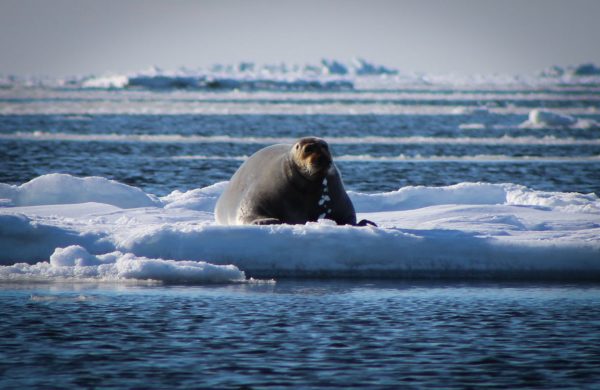
As sea ice in the Arctic decreases due to climate change, it’s opening the way for more than cruise ship travel. Scientists have found evidence that links the decline of sea ice to the emergence of a virus in Arctic marine mammals that has killed thousands of seals in European waters.
While the virus isn’t proving harmful to Arctic species and those who subsist on them, its presence highlights a new disease risk for the region.
In two outbreaks — one in 1988 and another in 2002 — the phocine distemper virus (PDV) killed thousands of European harbor seals in the North Atlantic Ocean. University of California Davis researcher Tracey Goldstein says the virus spread to multiple species, but hit seals the hardest.
“The virus in seals causes them to have respiratory disease, they get pneumonia,” Goldstein said. “It also affects their neurologic systems, so you’ll see animals coming up on the beaches coughing, some of them having seizures, being unaware of their surroundings.”
The disease is native to the Atlantic Ocean, but in 2004, PDV was found in Arctic sea otters for the first time.
Since the early 2000s, the Arctic has seen declining sea ice, opening new open water pathways between the Arctic and Pacific Oceans. A 15-year study published this month by Goldstein and other UC Davis researchers found that the new pathways are allowing contact between Arctic and sub-Arctic populations. Goldstein says that means diseases can also be carried across oceans.
“As ice changes, and animals move further, they will come in contact with new species and bring whatever it is that they normally have that may not be killing them into the Arctic,” Goldstein said. “And so we just have to be aware of that and continue to monitor for that.”
The study found that, since 2001, there have been various spikes of PDV in Steller sea lions, bearded ring seals and various other Arctic marine mammals. But Goldstein says there was no correspondence between the PDV spikes and marine mammal deaths.
“We know it’s here, but we’re not at the moment seeing wide evidence that it’s killing seals,” Goldstein said. “So that’s good news for us, and it might mean that the seals in the Pacific are just not as susceptible as harbor seals in the Atlantic.”
And Goldstein says that just like measles, which only affects humans, the virus doesn’t hurt species that feed on those mammals.
“So people up there won’t get sick from the virus, and their children won’t get sick,” Goldstein said. “It’s definitely not a human health concern.”
Goldstein says that PDV is the first major example of a virus travelling between ocean marine species, and while this particular virus isn’t doing widespread damage, its emergence opens the door for other viruses to pop up between oceans. And it’s something researchers will have to continue to monitor as sea ice continues to diminish.
Wesley Early covers Anchorage life and city politics for Alaska Public Media. Reach him at wearly@alaskapublic.org and follow him on X at @wesley_early. Read more about Wesley here.





